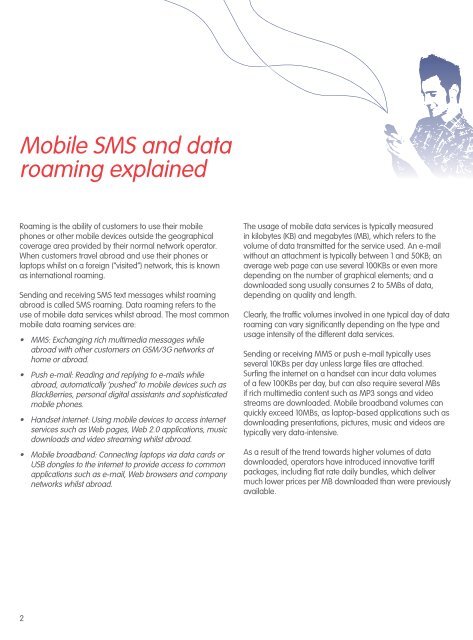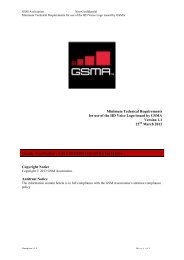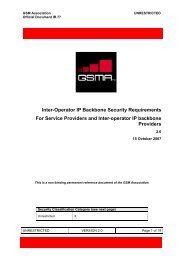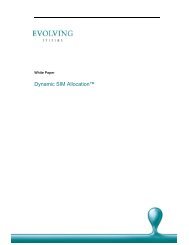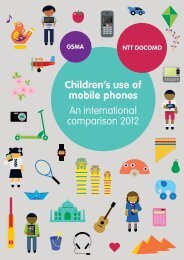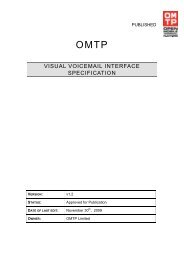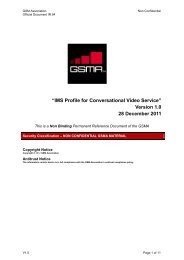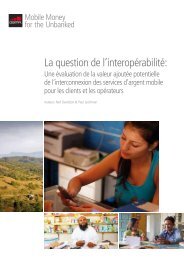Mobile SMS and Data Roaming Explained - GSMA
Mobile SMS and Data Roaming Explained - GSMA
Mobile SMS and Data Roaming Explained - GSMA
Create successful ePaper yourself
Turn your PDF publications into a flip-book with our unique Google optimized e-Paper software.
<strong>Mobile</strong> <strong>SMS</strong> <strong>and</strong> data<br />
roaming explained<br />
<strong>Roaming</strong> is the ability of customers to use their mobile<br />
phones or other mobile devices outside the geographical<br />
coverage area provided by their normal network operator.<br />
When customers travel abroad <strong>and</strong> use their phones or<br />
laptops whilst on a foreign (“visited”) network, this is known<br />
as international roaming.<br />
Sending <strong>and</strong> receiving <strong>SMS</strong> text messages whilst roaming<br />
abroad is called <strong>SMS</strong> roaming. <strong>Data</strong> roaming refers to the<br />
use of mobile data services whilst abroad. The most common<br />
mobile data roaming services are:<br />
• MMS: Exchanging rich multimedia messages while<br />
abroad with other customers on GSM/3G networks at<br />
home or abroad.<br />
• Push e-mail: Reading <strong>and</strong> replying to e-mails while<br />
abroad, automatically ‘pushed’ to mobile devices such as<br />
BlackBerries, personal digital assistants <strong>and</strong> sophisticated<br />
mobile phones.<br />
• H<strong>and</strong>set internet: Using mobile devices to access internet<br />
services such as Web pages, Web 2.0 applications, music<br />
downloads <strong>and</strong> video streaming whilst abroad.<br />
• <strong>Mobile</strong> broadb<strong>and</strong>: Connecting laptops via data cards or<br />
USB dongles to the internet to provide access to common<br />
applications such as e-mail, Web browsers <strong>and</strong> company<br />
networks whilst abroad.<br />
The usage of mobile data services is typically measured<br />
in kilobytes (KB) <strong>and</strong> megabytes (MB), which refers to the<br />
volume of data transmitted for the service used. An e-mail<br />
without an attachment is typically between 1 <strong>and</strong> 50KB; an<br />
average web page can use several 100KBs or even more<br />
depending on the number of graphical elements; <strong>and</strong> a<br />
downloaded song usually consumes 2 to 5MBs of data,<br />
depending on quality <strong>and</strong> length.<br />
Clearly, the traffic volumes involved in one typical day of data<br />
roaming can vary significantly depending on the type <strong>and</strong><br />
usage intensity of the different data services.<br />
Sending or receiving MMS or push e-mail typically uses<br />
several 10KBs per day unless large files are attached.<br />
Surfing the internet on a h<strong>and</strong>set can incur data volumes<br />
of a few 100KBs per day, but can also require several MBs<br />
if rich multimedia content such as MP3 songs <strong>and</strong> video<br />
streams are downloaded. <strong>Mobile</strong> broadb<strong>and</strong> volumes can<br />
quickly exceed 10MBs, as laptop-based applications such as<br />
downloading presentations, pictures, music <strong>and</strong> videos are<br />
typically very data-intensive.<br />
As a result of the trend towards higher volumes of data<br />
downloaded, operators have introduced innovative tariff<br />
packages, including flat rate daily bundles, which deliver<br />
much lower prices per MB downloaded than were previously<br />
available.<br />
2


